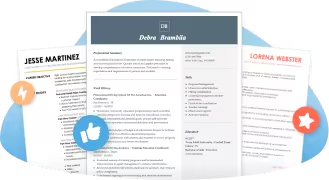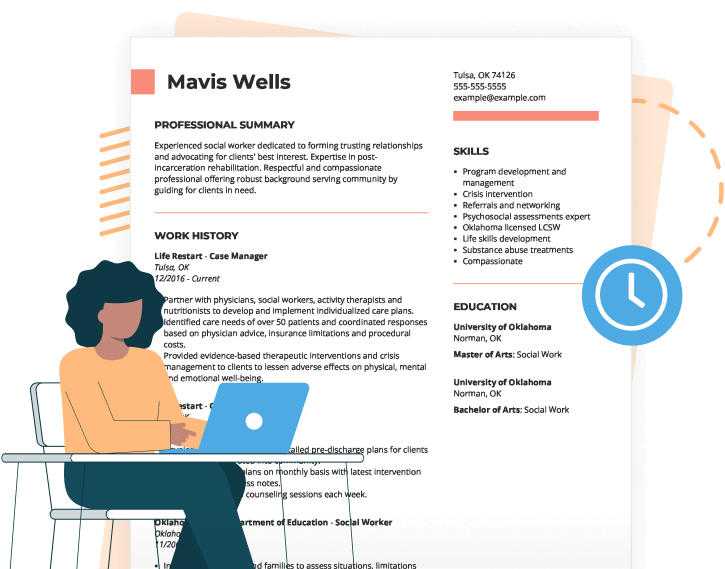Featured Resume Examples
Looking for more examples? Check out our other top-requested architecture resume examples for project coordinator, landscape architect and AutoCAD drafter. And if you want others, keep scrolling!
Search Architecture Jobs
Architecture Resumes by Job Title
Find the resume example you need by browsing these specific Architecture categories:
Data and Computer Roles (19)
Design and Quality Roles (11)
Senior and Leadership Roles (4)
Support Roles (4)
Cover Letter Examples for Architecture Jobs
Job Outlook
Architecture employment is expected to grow 1% by 2029 according to the U.S. Bureau of Labor Statistics. This slower than average projection is due to the improvement of software and measuring technologies. These advancements increase architects’ productivity, thus lowering the number of new hires.
For similar reasons, landscape architects’ employment is projected to decline 2% in the next decade, while drafters’ employment may decrease by 4%.
Technology plays a massive role in our world. That’s why it’s essential for architecture candidates to be proficient in computer-aided design (CAD) and building information modeling (BIM) technologies.
It’s also incredibly important to have a fantastic resume and a portfolio that shows what a great candidate you are. We’re here to help you get started with our professional writing tips!
3 Tips for Writing Architecture Resumes
Choose the Right Format for Your Architecture Resume
Choosing the right resume format is the first step towards getting the architecture job you want. You can see it as the foundation, as the resume format dictates how your skills and experience will be organized based on your years of experience.
A chief architect with over ten years of work experience would go for the chronological resume. This resume format focuses on work history. It chronologically shows career progression — how the candidate went from being an architecture intern to a chief architect — and the achievements made along the way.
On the other hand, if a candidate just graduated from college, and they’re an architecture intern with the desire to keep growing their career, then the functional resume is their best friend.
This format works perfectly for people who have less than two years of experience or are changing industries. It focuses on the skills and education sections, instead of the work history, to show the hiring manager that you have the qualifications to not only get the job done, but grow as you go.
In-between these two, however, is the junior architect. They’ve been working in the architecture industry for a good four years, so they know a thing or two, and they want to apply to a new company. For them, it’s best to choose the hybrid format.
As the name suggests, this resume format mixes the chronological and the functional formats, allowing you to organize both your work experience and the professional skills you’ve learned along the way.
It’s perfect for people who have been in the architecture industry for a couple of years, but no more than five.
Understanding each resume format is the first step to creating a resume that turns heads. Decide which one is the best fit for you and start writing!
Promote Sought-After Resume Skills
Once you choose the right format, it’s time to decide the skills you’re going to highlight on your resume.
It’s clear that each architecture role is different and that not all share the same responsibilities. Still, there are certain skills that all hiring managers like to see in their architecture candidates.
Take a look at the list below and choose the ones that apply to you:
- Design
- Creativity
- Mathematics
- Drawing
- Concept creation
- Construction methodology
- Planning
- Zoning and building codes
- Problem-solving
- Critical thinking
- Revit
- BIM
- AutoCAD
- Deltek
- Microsoft Office
- Newforma
- Organization
- Communication
- Team player
- Self-discipline
- Time management
- Attention to detail
- Multitasking
- Photoshop
- Knowledge of construction materials
- Client management
- Proactive
- SketchUp
- Project management
- Illustrator
- InDesign
- Passionate
- Flexible
- Work under pressure
- Commercial design
- Industrial design
- Urban design
- Results-oriented
Be sure to add about six to eight of these skills in your resume to show the hiring manager you’re what they’re looking for.
Use a Template to Make Your Resume Look Modern
As an architect, you know how to design structures that are efficient and look good. Your resume should work the same way, and at JobHero we have all the tools to help you.
We have tons of examples and modern resume templates ready for you to customize any way you want. All it takes is one click to change the color and font.
Using our Resume Builder is even easier. You can organize your experience and skills any way you want; the builder suggests keywords and even marks spelling mistakes.
Designing the architecture resume of your dreams only takes a few minutes. Once it’s done, you can save it and send the hiring managers your finished work.
FAQ
How do I work in architecture?
You need to do a couple of things to work in architecture, particularly if you want to be an architect.
In the U.S., architects must have a bachelor’s degree in architecture and be licensed.
The National Council of Architectural Registration Board has a great tool to learn the specific requirements by state to earn the license, but usually, you must have a degree in architecture, complete an internship and then pass the Architect Registration Examination.
Most states also require you to attend workshops, university classes, conferences and other forms of continuing education to keep the license, though this varies by state.
The case is similar for landscape architects. They also need a bachelor’s degree in landscape architecture and a state-issued license awarded by the Council of Landscape Architectural Registration Boards.
But it’s not the same across the board. For example, drafters only need an associate degree of applied science in drafting or a related degree. However, some drafters opt to get a certificate from the American Design Drafting Association instead.
If you have architecture certifications, learn how to include them in a separate section of your resume.
How much do people in architecture get paid?
Architecture offers an above-average salary across all levels.
According to the U.S. Bureau of Labor Statistics, the median annual salary for architects is $80,750. Simultaneously, landscape architects earn an average of $69,380 a year, while drafters make around $56,830 annually.
The numbers look good. If architecture is the industry for you, consider using our Resume Builder to create a resume that helps you shine and gets you the job you want.
Is it hard to work in architecture?
Architecture is a highly specialized career. Most people who work in architecture work full-time and some work extra hours, especially when a deadline is approaching. They spend a lot of time in their offices to meet clients, create reports and draft drawings. Sometimes they visit construction sites to make sure everything is running well.
Similarly, landscape architects create plans and designs in their offices, but they spend the rest of their time at job sites.
Architecture is a fun, creative and dynamic industry where every day is a little bit different, but hard specialized skills are required.
Is a portfolio important to work in architecture?
A million times yes!
Most job postings will ask you to submit a portfolio alongside your resume — a portfolio is the greatest tool to show the hiring managers your potential.
Whether you have years of experience as an architect or just graduated from university, your portfolio is your chance to visually show what you’re capable of envisioning and putting together.
Though there are architects who have their portfolios online in the form of a webpage or a professional social media page, some prefer to create it in programs like InDesign and attach it to the job application as a PDF.
If you have a link, we suggest adding it underneath the email address in the contact section of your resume, or creating an online portfolio section at the bottom of your resume.
Should I include a cover letter with my architecture resume?
Yes!
Even if the job posting doesn’t mention it, be sure to include a cover letter with your resume and portfolio because it will help you look more professional and stand out.
A cover letter is a space where you can draw in the hiring manager by telling them your professional story. You can further discuss your skills, experience and achievements, like how a design came to life or any awards that you’ve won.
If you think of the resume as the foundation, your cover letter is the window from which hiring managers can peek at who you are as an architect.
Start putting them together by checking out our great selection of architecture cover letter examples to get inspired.







